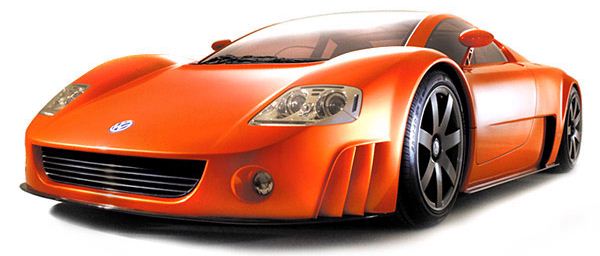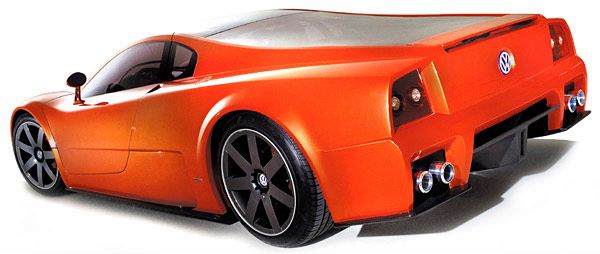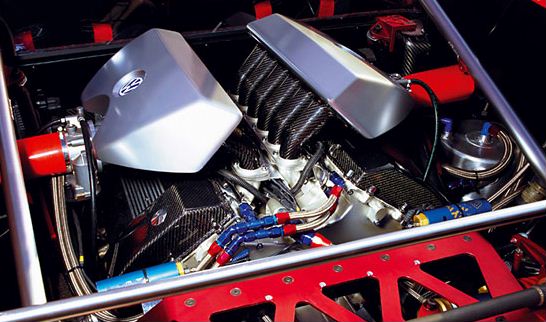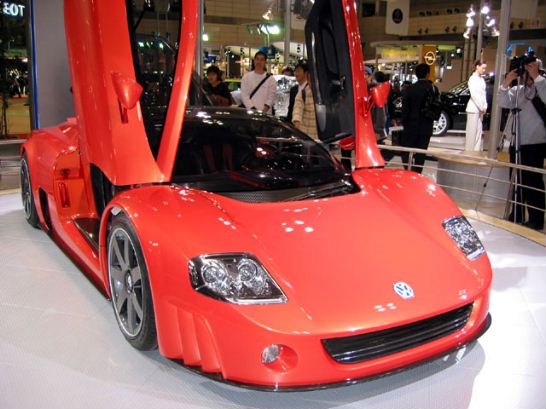|

Volkswagen sets a few records and introduces yet another W12 Sportscar concept
On October 14th a prototype of Volkswagen's new W12 Coupe in the final stages of development set the
world speed record for distance covered in "24 hours". The 440 kW/600 bhp twelve-cylinder sports car covered 7,085.7 kilometres (4,402.8 miles) at an average speed of 295.24 km/h (183.45 mph). It thus
toppled the previous record by a margin of twelve km/h (7.5 mph). In the Volkswagen W12 Coupe capable of 350 km/h (217 mph), which had not been specially prepared for the long-distance record bid, the team of
drivers also set two other world records (over 5,000 kilometres and 5,000 miles) and six international vehicle class records. The class record for "12 hours" had already been broken in a trial run.
All world and class records are subject to recognition by the Federation Internationale de l'Automobile (FIA); therefore the record-breaking drives on the high-speed circuit at Nardo near Lecce in southern Italy were
carried out in accordance with the official FIA regulations. The aim of putting the vehicle through this gruelling 24-hour ordeal was to analyse the performance potential and the robustness of the twelve-cylinder
engine. As can be seen from the remarkable records and the first technical analyses of the drive unit, an ideal set of the results was achieved, exceeding the defined requirements.
Volkswagen is showing the original record-breaking vehicle and a possible production version of this concept will be making its debut at the Tokyo Motor Show from October 24th to November 7th. Before then,
however, the twelve-cylinder engine will be put to use from spring 2002 in the in the new luxury saloon from Volkswagen, internally know as Project D1. In this case the 6.0-litre engine will produce 309 kW / 420 bhp.

Volkswagen W12 Coupe
An exotic sports car badged as a VW? Believe it. Volkswagen showed its third iteration of the W12 Coupe at
the 2001 Tokyo Motor Show. Actually, two cars were in attendance. The first was an unpainted race version used to set the 24-hour world speed record, and the second was dressed up in theoretical production car trim.
On October 14, 2001, a black carbon-fiber-body W12 Coupe was used to break the world speed record for distance covered in 24 hours. The car covered 4,402.8 miles at an average speed of 183.45 mph. Once
recognized by the Federation Internationale de l'Automobile (FIA), this number will best the previous record by a margin of 7.5 mph. In the midst of the excitement, Volkswagen says that two other world speed records
and six international vehicle class speed records were broken. Afterward, the coupe was shipped directly to Japan, and motor show attendees noted that its body was still covered in road grime and splattered bugs. At
least the bugs died quickly — the car's top speed is 217 mph.
You, too, could try to attain this speed on your way to the local Kwik-E-Mart, if a production version of the
W12 Coupe becomes reality. Although the coupe dressed for public scrutiny included leather seats, air conditioning, GPS navigation and a mobile phone (handy for when you need to call your lawyer before the
cops drag your butt off to jail), there's little difference between the two cars. This is definitely a racecar, paint or no paint.
Most important to either car is the mid-mounted W12 engine. "W" refers to Volkswagen's new family of engines. How do you make a W12? Take two narrow-angle four-valve V6 engines and configure them at an
angle of 72 degrees apart from one another with a shared crankshaft. This layout could be described as a
"V-V" arrangement, or a "W." The same engine layout is used in the European-market Audi A8 W12, with four
fewer cylinders in the 2002 Passat W8 and with 16 cylinders in the upcoming Bugatti EB Veyron. In the coupe application, the W12 displaces 6.0 liters and makes 600 horsepower at 7,000 rpm and 458 lb-ft of torque at
5,800 rpm. Power is applied to the rear wheels via a six-speed sequential-shifting manual gearbox.
Of course, there's more to the W12 Coupe than explosive power — a fully independent double-wishbone
suspension, nearly 50/50 weight distribution and 12.5-inch ventilated Brembo brakes should make it quite popular on the turns, as well. Should you, the hypothetical driver, feel a bit overwhelmed, the car's standard
Electronic Stability Program (ESP) and traction control system can intervene on your behalf, using both the brakes and the central engine management system to get you back on track. Also included are electronic
differential locks (EDL), which prevent excessive wheelspin at speeds below 25 mph (by applying the brakes). Drivers can disable all of this technology when desired.
By employing monocoque construction (in which the body shell bears most of the stress) and housing the engine behind the passenger compartment, engineers were able to give the W12 Coupe an exceptionally
long, low body — at 43 inches in height, it's about as tall as a Diablo. Take a good look at the wedge-shaped headlights and round taillights, as these suggest the styling of future high-end production VWs. The
wing-shaped driver and passenger doors scissor upwards, while the engine's transparent cover opens up like a hatchback.
Inside, the heavily bolstered seats are covered in leather and quilted suede. Drilled aluminum pedals hover aggressively in the footwell. The smooth leather steering wheel is not perfectly round, as it is designed to
mirror the form and function of those used in Formula One racing. A simple instrument layout puts the most important gauges right in front of the driver.
While Volkswagen has said that the W12 Coupe is more than a just a show car, we think it's more likely to show up on posters for 12-year-old boys before you see one in your neighbor's driveway (unless, of course,
your neighbor happens to be Jay Leno or some super-rich tycoon dude). Should Ferrari and Lamborghini be worried? Not if history is an indicator. Other automakers — namely Nissan and Jaguar — have tried to enter
the supercar realm and have come away tails tucked. When it comes to this type of vehicle, prestige and history are just as important as, if not more than, cylinders and horsepower.

More interesting for the immediate future is the W12 Coupe's engine. Already available in the Vaterland as an
option for the Audi A8, this engine will be offered in Volkswagen's upcoming super luxury car (the 2003 Phaeton) and premium SUV (which should arrive for 2002). Though certainly detuned for these cars, the W12
engine could make around 400 horsepower — 420 in the current A8 — making for some seriously fast VWs.. A Mid-Engine Supercar for the People? By Erin Riches and Brent Romans

|



